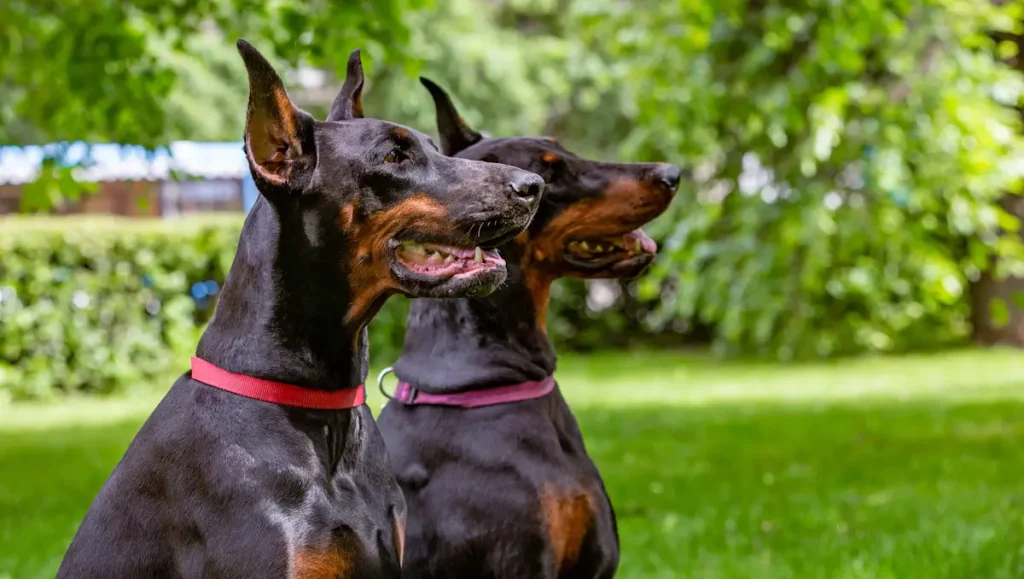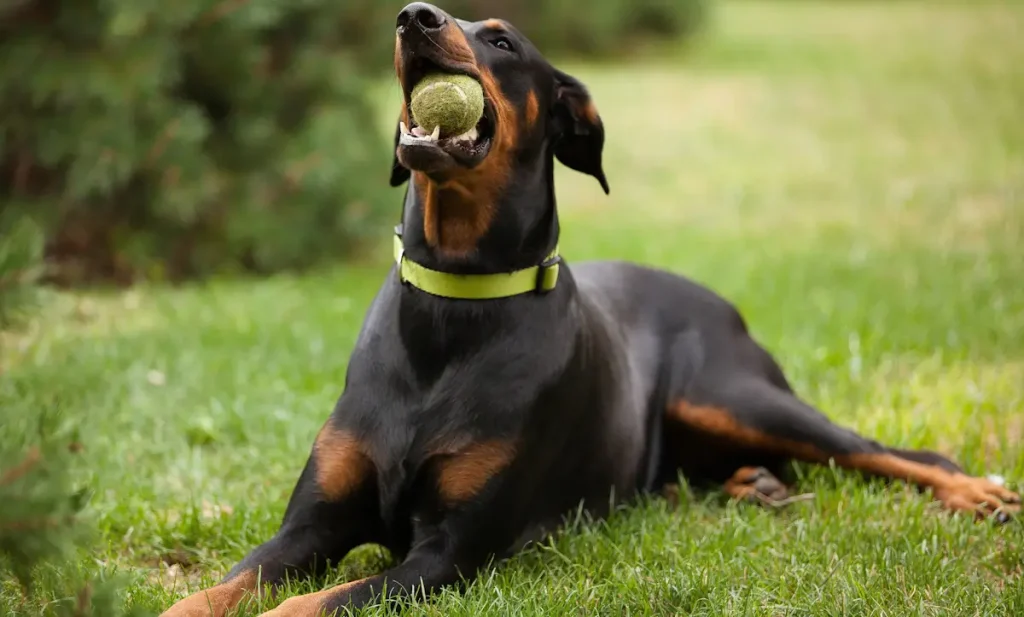In the United States, the Doberman Pinscher ranks as the 17th most popular dog breed according to the American Kennel Club—a testament to their enduring appeal. As you consider the sleek, powerful form of the Doberman, you might find yourself drawn to their well-documented protective instincts, which have made them legendary as both guardians and loyal companions.
Yet, there’s more to these dogs than meets the eye. Their intelligence and versatility have led them to various roles, from police work to therapy. When you look beyond their intimidating facade, you’ll find a breed with a complex character requiring nuanced understanding.
Remember that this breed isn’t just about its ability to protect; you’ll want to explore how its protective nature shapes its interactions with family and the environment that allows it to thrive.
- Noise Level
- Energy
- Sociability
- Trainability
- Care
- Health
Overall
Summary
The Doberman Pinscher is rated as moderately noisy, highly energetic, moderately sociable, very trainable, moderately demanding in care, and generally in good health.
Doberman Pinscher: Traits, Temperament, and Care Guide
The Doberman Pinscher combines a muscular build, keen intelligence, and a loyal temperament. It requires dedicated care and training to thrive as a companion and protector.
Prioritize early socialization and firm, consistent obedience training using positive reinforcement techniques to harness their protective instincts.
Potential family dogs necessitate regular exercise and vigilance for health issues to maintain their well-being.
Exploring the Characteristics of the Doberman Pinscher
Understanding the distinctive traits of the Doberman Pinscher can help potential owners provide the best possible care for this intelligent and powerful breed. Their breed profile emphasizes an instinct for protection, showcasing their role as loyal family guardians.
| Trait | Importance | Effect |
|---|---|---|
| Muscular Build | Physical Health | Prevents hip dysplasia |
| Early Socialization | Behavioral Development | Mitigates aggression |
| Protective Instincts | Safety | Serves as guard dogs |
Your Doberman’s temperament of guarding instincts requires consistent training and socialization.
Doberman Pinscher: A Comprehensive Profile and Guide
You’re considering the Doberman Pinscher, a breed distinguished by intelligence and athleticism.
Understanding their health predispositions and the importance of a structured training regime is imperative.
As you read on, you’ll uncover the essentials of providing a Doberman with a nurturing environment that caters to their physical and psychological needs.
Everything You Need to Know
Dive into the comprehensive profile of the Doberman Pinscher, an agile and robust breed that demands a nuanced understanding of its training, health, and social needs for optimal care.
- Training and Socialization:
- Foster protective instincts with consistent, firm training
- Ensure early socialization for a balanced temperament
- Health and Exercise:
- Monitor for health issues like hip dysplasia
- Provide regular exercise for physical and mental well-being
Discovering the Temperament
When exploring the temperament of Doberman Pinschers, it’s essential to recognize their unwavering loyalty and innate protective instincts.
As one of the dog breeds renowned for forming strong bonds, the Doberman’s personality is characterized by its instinct to protect. These naturally protective guardians exhibit bravery without undue aggression, thriving on socialization, which is crucial to their development.
Their traits of being quick learners and independent thinkers underscore their unique temperament.

Doberman Pinscher: Is It a Good Fit for Families?
You may wonder if a Doberman Pinscher is a suitable addition to your family unit. Analyzing their disposition, it’s clear that they flourish in environments where structure and affection coexist, provided they receive the necessary training and socialization from a young age.
Considering their innate protective qualities and intelligence, Dobermans can integrate well as vigilant, loyal companions in a family context.
Assessing Doberman Pinscher’s Compatibility with Families and Kids
Often, families considering a Doberman Pinscher as a pet wonder about the breed’s compatibility with children and the home environment.
They’re highly intelligent, eager to protect and guard, and with early socialization, they provide positive experiences for family members of different ages, becoming cherished family pets.
Doberman Adjusts to Environments
Dobermans possess a remarkable ability to adapt to various living situations, whether it’s a bustling city apartment or a spacious suburban home. With proper training and socialization, your Doberman Pinscher’s adaptability shines.
They’re quick learners and, given consistent training, will meet exercise requirements, ensuring their protective instincts are balanced with a well-adjusted temperament. Remember, mental stimulation is as crucial as physical activity for their adjustment.
Doberman Training Essentials
As you train your Doberman, understand that consistency and a firm approach are non-negotiable for instilling obedience.
You’ll need to integrate early socialization into your regimen to mitigate potential aggression issues.
Effective Training Strategies
To effectively train a Doberman Pinscher, it’s imperative to start with early socialization to mitigate potential aggression towards unfamiliar people and animals.
| Training Focus | Strategy |
|---|---|
| Early Socialization | Introduce to various environments and beings |
| Basic Obedience | Consistent training with basic commands |
| Exercise and Mental Stimulation | Daily physical activity and puzzles/games |
| Positive Reinforcement | Rewards for desired behavior |
| Professional Guidance | Enroll in obedience classes with a trainer |
Exercise and Grooming Needs
Ensuring your Doberman Pinscher regularly exercises and adheres to a grooming routine is critical for maintaining their physical health and mental sharpness.
With its high energy level, this active breed requires regular exercise to prevent destructive behaviors.
Daily physical activity, including long walks, is essential to satisfy their mental and physical needs.
Aim for substantial exercise per day to nurture their well-being.

Health Considerations
As you consider a Doberman Pinscher as your companion it’s contingent on managing common health issues effectively.
You’ll need to monitor their health for conditions like hip dysplasia and heart problems, which necessitate routine veterinary care. Additionally, genetic disorders such as Von Willebrand’s Disease and Dilated Cardiomyopathy should be on your radar for early detection and management.
Common Health Issues and Lifespan
What health issues should you watch out for in Doberman Pinschers?
Dobermans are prone to certain health concerns, such as hip dysplasia and dilated cardiomyopathy, a genetic condition often leading to heart failure. Von Willebrand’s disease and Wobbler syndrome also pose potential health issues. Regular veterinary check-ups are crucial.
How long can they typically live?
Bred by Karl Friedrich Louis Dobermann to be vigilant protectors, these best guard dogs typically live 10-13 years.
Is Doberman Pinscher the Right Pet for You?
Considering a Doberman Pinscher as your next pet requires a close examination of its unique needs and characteristics to determine whether it aligns with your lifestyle and expectations.
Their strong protective instincts, high exercise requirements, and need for regular socialization are critical to their care and maintenance.
Assess their temperament, potential health issues, training needs, and family compatibility to ensure a Doberman is the right guard dog for your home.
Alternatives for Doberman Pinscher: Intelligent and Protective Large Breeds
For those who adore the Doberman Pinscher’s intelligence and protective nature, these large breeds offer a similar combination of smarts and guardianship.
| Similar Dogs | Short Description |
|---|---|
| German Shepherd | Highly intelligent and versatile, known for its protection and working abilities. |
| Rottweiler | Robust breed, great for protection, known for its loyalty. |
| Belgian Malinois | Highly trainable and active, often used in demanding roles like police work. |
| Boxer | Energetic and playful, great with families, known for its protective nature. |
| Rhodesian Ridgeback | Known for its distinctive ridge and courage, great for active families. |
Conclusion
As the guardian of your castle, the Doberman Pinscher stands vigilant, much like a knight of yore. They’ll serve loyally with proper care—grooming, diet, and exercise.
Their sharp minds require training, and their robust form requires consistent exercise. Heed health warnings to ensure your Doberman’s longevity.
In the tapestry of your life, this breed could be the perfect thread, if their bold spirit and protective nature suit your family’s weave. Choose wisely, for their tale is yours to write.
Frequently Asked Questions
Do Dobermans Have Protective Instinct?
You’ve asked about Dobermans’ protective instinct. Their guardian nature and instinctual behavior make them loyal companions. Their temperament traits demand training importance and socialization impact to balance alert behavior with family guardians’ defense mechanisms and canine loyalty.
What Is the Profile of Doberman?
Dobermans boast an athletic build, varied coat colors, and high energy levels. They’re intelligent guardians with notable protective instincts. Health concerns necessitate vigilant care. Proper training and socialization ensure family compatibility and harness their temperament.
Are Dobermans Bred for Protection?
Yes, you’re right; Dobermans are indeed bred for protection. Their guardian heritage and breed history underline their temperament traits, which, with proper training influence and socialization importance, dispel aggression myths, showcasing companion loyalty and intelligence perception.
Why Is My Doberman so Protective?
Your Doberman’s protective nature is like a knight’s loyalty; it’s ingrained. Training, socialization, and understanding their personality can mitigate anxiety-driven behaviors, ensuring they don’t misread situations due to environmental triggers or bonding factors.
